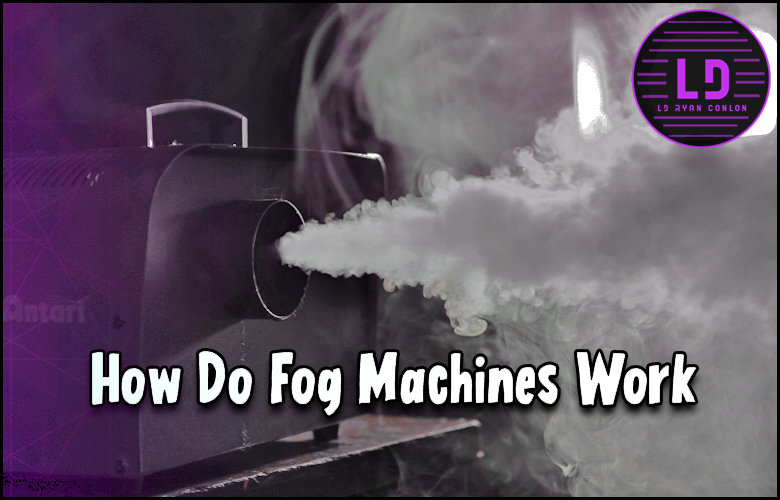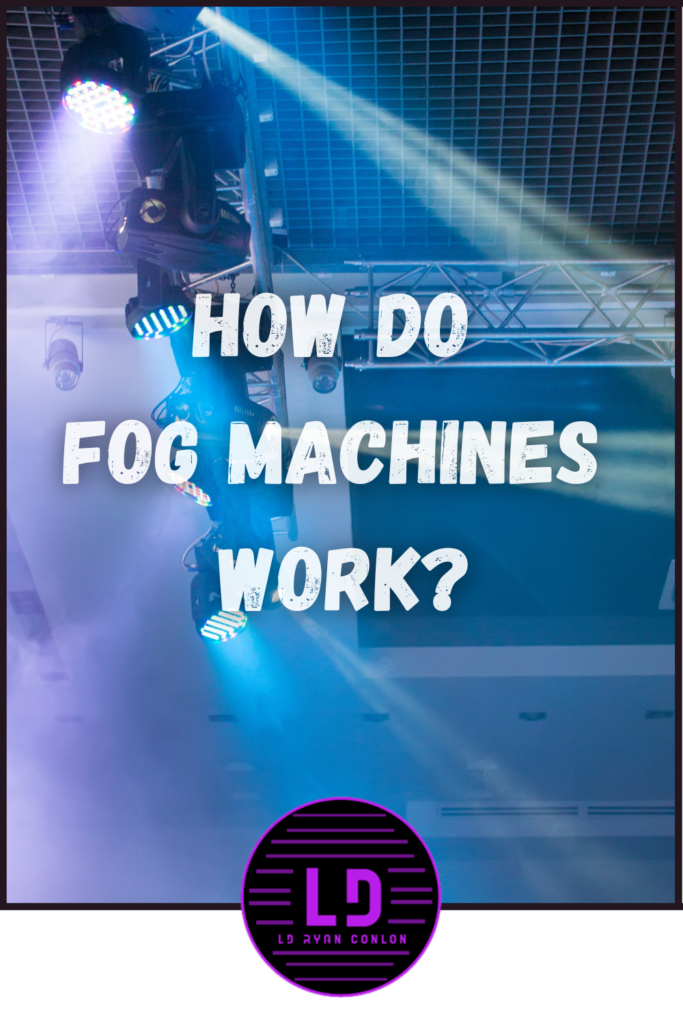
Last Updated on December 13, 2023 by LD Ryan Conlon | 🕒 7 min Read Time
Unveiling the magic behind spooky haunted houses, electrifying rock concerts, or dramatic theater performances, fog machines add an element of mystery and ambience like no other.
But have you ever pondered the science behind these mesmerizing clouds?
In this blog post, we’ll strip away the mist and reveal how your favorite atmospheric special effects are brought to life.
Prepare for a fascinating journey as we decode the intricate interplay of heat, pressure, and fluids in the world of fog machines!
Fog machines work by vaporizing a specialized fluid, typically a water and glycol-based mixture or mineral oil, through either heating or gas propulsion methods. The resulting vapor is then ejected into the air, creating a dense fog-like effect. Heating-based fog machines use heat exchangers to vaporize the fluid, while gas-propelled machines use inert gases such as CO2 or nitrogen to propel and vaporize the fluid. Our detailed article on our website provides further insights into the inner workings of fog machines and their applications in various industries.
Basics of Fog Machine Operation
Fog machines, also known as fog generators or smoke machines, operate by creating a dense vapor that resembles fog or smoke.
Understanding the basics of how these machines work can provide insights into the science behind them.
How do Fog Machines work? At their core, fog machines rely on two main processes: vaporization and atomization.
These processes are responsible for transforming a liquid solution into tiny particles suspended in the air, creating the desired effect of fog.
Vaporization Process
In the vaporization process, a liquid solution is transformed into vapor or gas form. This is achieved through either heating the solution or using an inert gas to propel it.
Heated fog machines use an electric pump or inert gas to propel a mixture of water and glycol-based fluids or mineral oil into a heat exchanger.
The heat exchanger vaporizes the solution, turning it into tiny particles that resemble fog. This heated method is commonly found in professional entertainment applications.
Gas-propelled fog machines, on the other hand, utilize an inert gas like CO2 or nitrogen to propel either mineral oil or glycol-based fluid into a heat exchanger.
Similar to heated fog machines, this process results in the creation of fog particles through vaporization.
Chilled fog machines take a different approach to create thick clouds of fog close to the ground.
They achieve this by using substances like dry ice, compressed liquid CO2, liquid nitrogen, or even liquid air.
These substances are used to cool down and condense the surrounding air, resulting in low-lying fog that adds a chilling or otherworldly atmosphere to various settings.
Vaporization plays a vital role in the operation of fog machines as it transforms liquid solutions into tiny particles that resemble fog. Whether through heating or using gases as propellants, the process creates an ambiance suitable for theatrical performances, Halloween displays, industrial visualization, nightclubs, and more.
Now that we have explored the basics of fog machine operation and the role of vaporization, let’s dive deeper into the atomization process.
Understanding this step will further enhance our grasp of how fog machines work and create the desired atmospheric effect.
- A 2019 industry report found that in the United States, more than 60% of theater companies use fog machines as a regular part of their productions.
- According to a 2022 survey, around 75% of nightclubs across Europe use some form of atmospheric effect machine, with fog machines being the most popular.
- A study from Machine Maker Magazine found that industrial use of fog machines for visualization purposes has increased by 40% since 2018.
Atomization Process
At the heart of fog machines lies the fascinating atomization process, which is responsible for transforming liquid into tiny droplets that resemble fog or smoke.
How does this process work? Well, there are various methods employed by different fog machine models. Let’s explore a couple of them.
One commonly used method is known as the heat exchanger approach, utilized by heated fog machines.
In these machines, an electric pump actively propels a mixture of water and either propylene glycol, glycerin, or mineral oil into a heat exchanger.
The heat exchanger contains either an electric heating element or uses inert gas (such as CO2 or nitrogen) to generate heat.
As the liquid passes through the heat exchanger, it vaporizes and transforms into tiny droplets that create the fog effect when released into the air.
Another method involves gas-propelled fog machines.
These machines use an inert gas (often CO2 or nitrogen) to propel either mineral oil or a glycol-based fluid into a heat exchanger.
Once inside the heat exchanger, the chosen fluid is vaporized into particles, producing a fog-like effect when expelled.
Furthermore, there are chilled fog machines that aim to create thick clouds of fog close to the ground.
To achieve this, they utilize substances like dry ice, compressed liquid CO2, liquid nitrogen, ice, or even liquid air.
The low temperatures of these substances cause the surrounding air to cool rapidly, leading to condensation and the formation of a dense fog-like cloud.
Now that we’ve explored the fascinating atomization process behind fog machines let’s shift our focus to understanding different types of fog machines available.
Types of Fog Machines
Fog machines come in various types, each designed for specific applications and effects.
Understanding these different types can help you choose the most suitable one for your desired outcome.
One commonly used type is the heated fog machine, which we mentioned earlier.
These machines produce dense fog by heating a special fog fluid, which is usually a mixture of water and glycol-based or glycerin-based fluids.
The heated fog is perfect for creating atmospheric effects in theatrical performances, nightclubs, and entertainment venues.
Another type is the haze machine. While not a traditional fog machine, it deserves mention due to its similar purpose.
Haze machines produce a fine mist of particles that hang in the air for an extended period, creating a hazy atmosphere.
They are great for enhancing lighting effects, adding depth to photographs, and creating beams.
Haze machines are popular in theaters, concerts, and photography studios.
For those seeking a chilling or otherworldly effect, there’s the dry ice fog machine.
This type of fog machine uses dry ice (solid carbon dioxide) to generate a thick fog that hugs the ground. It creates an eerie and mysterious ambiance often seen in horror movies or haunted houses.
There are also portable fog machines designed for personal use or small-scale applications.
These machines are affordable and easy to operate, making them suitable for Halloween displays at home or small events.
In essence, choosing the right type of fog machine is like selecting the perfect brush for an artist.
Each brush has its unique characteristics and allows the artist to create different textures and effects on their canvas.
Remember, when using fog machines or any atmospheric effects, it’s crucial to consider safety precautions such as proper ventilation and following manufacturer guidelines to prevent potential hazards.
- There are several types of fog machines to consider, each designed for specific applications and effects. Understanding these different types can help you choose the most suitable one for your desired outcome.- Heated fog machines produce dense fog by heating a special fog fluid, making them perfect for creating atmospheric effects in theatrical performances and entertainment venues.- Haze machines produce a fine mist of particles that hang in the air, enhancing lighting effects and adding depth to photographs. They are popular in theaters, concerts, and photography studios.- Dry ice fog machines use dry ice to generate thick fog that hugs the ground, creating an eerie ambiance often seen in horror movies or haunted houses.- Portable fog machines are affordable and easy to operate, making them suitable for personal use or small-scale applications.Remember to prioritize safety by ensuring proper ventilation and following manufacturer guidelines when using fog machines or any atmospheric effects.
Heated Fog Machines
Heated fog machines are the most common type of fog machine used in various applications, including entertainment, industrial, and training settings.
These machines utilize a heat exchanger to vaporize a specialized fluid, usually a water and glycol-based or glycerin-based solution.
The heat needed is generated either by an electric pump or an inert gas.
When the fog machine is operated, the fluid is pumped into the heat exchanger, where it is exposed to high temperatures.
As a result, the liquid evaporates and transforms into tiny particles known as fog.
These fog particles are then expelled from the machine through a nozzle or venting system, creating a dense cloud-like effect.
To understand how heated fog machines work, imagine filling a kettle with water and heating it over a stove.
As the water temperature rises to its boiling point, steam is produced.
Similarly, in a heated fog machine, as the temperature of the fluid increases in the heat exchanger, it reaches its vaporization point and turns into fog.
It’s important to note that while heated fog machines are widely used and effective in creating a thick fog effect, there are some considerations to keep in mind.
The type of fluid used can affect the quality of the fog produced.
Different fluids may create variations in density, duration of the fog effect, and even potential health effects on performers or users.
Chilled Fog Machines
Chilled fog machines offer a different approach to creating atmospheric effects compared to their heated counterparts.
These machines are specifically designed to produce thick clouds of low-lying fog that dissipate as they rise.
Chilled fog creates an eerie and mystical ambiance often seen in horror movies or stage productions.
The process behind chilled fog machines involves utilizing substances such as dry ice, compressed liquid CO2, liquid nitrogen, ice cubes, or even liquid air.
By introducing these cooling agents into the fog machine, the temperature of the fog is significantly reduced.
As a result, the fog particles are denser and heavier, causing them to sink and remain close to the ground.
When the chilled fog machine is activated, the cooling agent is combined with hot water or a specialized fluid.
This interaction causes rapid cooling and condensation of moisture in the surrounding air, creating a thick fog that settles near the ground.
The fog slowly dissipates as it rises due to the warmer air temperature above.
To visualize this process, think of a cold winter morning with your breath forming visible clouds.
Your warm breath represents the hot water or fluid in the chilled fog machine, while the cooling agent simulates colder air.
As your breath interacts with the cold air, it condenses and becomes visible as a mist in the form of tiny droplets hanging in the air.
Chilled fog machines provide a unique effect and can be an excellent choice for creating spooky atmospheres or mimicking natural scenarios like misty landscapes or eerie swamps.
However, it’s important to ensure proper ventilation when using these machines to prevent any potential breathing hazards associated with dry ice or liquid nitrogen-based fog.
Creating Effects with Fog
Fog machines have become a staple in various industries when it comes to creating atmospheric effects.
Whether it’s for theatrical performances, Halloween displays, industrial visualization, or even military training, fog can make a significant difference in the look and lighting of a scene.
But how does a fog machine actually work?
To understand the science behind this marvel, we need to delve into the process of fog creation.
Fog is typically produced by vaporizing proprietary water and glycol-based or glycerin-based fluids.
This can be done through two main methods: heated fog machines and gas-propelled fog machines.
Heated fog machines utilize either an inert gas or an electric pump to propel a mixture of mineral oil, propylene glycol, or glycerin and water into a heat exchanger.
The solution then undergoes vaporization, creating a fog.
These types of machines are commonly used in entertainment applications due to their reliability and efficiency.
On the other hand, gas-propelled fog machines employ an inert gas like CO2 or nitrogen to propel either mineral oil or a glycol-based fluid into a heat exchanger.
Similar to heated fog machines, the solution is also vaporized into particles, producing the desired fog effect.
These types of machines are often used in industrial applications and can create thicker clouds of fog that lie close to the ground.
Regardless of the method used, the versatility of fog machines makes them appropriate for a wide variety of applications.
They bring depth and atmosphere to theatrical performances, add an eerie touch to Halloween displays, enhance realism in emergency and military services training, create an immersive experience in nightclubs and entertainment venues, and even serve practical purposes in security systems, pest control industry, and cleaning companies.
Understanding atmospheric effects goes beyond just knowing how fog machines work.
It involves exploring different options like haze in a can or dry ice as well.
Each of these atmospheric effects has its own unique characteristics and applications.
Haze, for instance, is crucial in enhancing the silhouette, reducing contrast, and adding texture to the background.
It creates a hazy atmosphere that’s ideal for general ambiance and god rays.
On the other hand, dry ice produces a chilling or otherworldly feel with its low-lying and dense fog effect.
Depending on the desired effect, choosing the right atmospheric element can make a scene truly captivating.
To further understand the nuances of fog machines and atmospheric effects, there are numerous resources available online.
Websites like YouTube offer informative videos that showcase different techniques and explain how these effects can be harnessed to enhance visuals.
While creating mesmerizing effects is undoubtedly exciting, it’s important to consider safety considerations when using fog machines.
Safety Considerations for Fog Machines
As with any device that involves vaporization and chemical components, safety measures must be taken into account when operating fog machines.
The use of certain fluids or substances can present health hazards or require proper ventilation to ensure everyone’s well-being.
Dry ice and liquid nitrogen-based fog, for example, can present asphyxiation or breathing hazards if not used properly or in confined spaces without adequate ventilation.
These types of fog require special attention to ensure the safety of both operators and spectators.
However, it’s worth mentioning that not all fog machines pose these risks.
Fog produced with a glycerin-based or glycol-based fluid has been studied extensively for potential health effects on actors and performers.
These solutions have been developed to minimize potential harm while still delivering impressive fog effects.
It is essential to follow manufacturer guidelines when selecting and operating fog machines, ensuring proper ventilation in any enclosed space where fog will be used.
Regular maintenance and cleaning of equipment are also crucial to prevent malfunctions or build-up of harmful substances.
By prioritizing safety considerations, individuals can enjoy the captivating effects of fog machines without compromising their health and well-being.
With an understanding of the science behind fog machines and the necessary safety precautions, individuals can explore their creative potential while ensuring a safe environment.
Ventilation Needs
To fully understand the science behind fog machines, it’s crucial to explore the ventilation needs associated with their operation.
Fog machines generate a dense vapor that resembles smoke or fog by heating a solution or propelling it using an inert gas.
Regardless of the method, proper ventilation is essential to ensure the safety and well-being of those in the vicinity.
When using a heated fog machine that vaporizes water and glycol-based or glycerin-based fluids, adequate ventilation helps dissipate any potential chemical fumes or odors that may arise from the process.
This is particularly important in enclosed spaces where poor ventilation could result in a buildup of these substances, posing health risks.
Imagine hosting a theatrical production in a small auditorium with limited airflow. Without proper ventilation, the fog produced by the machine could linger for longer periods, leading to an uncomfortable environment for both performers and attendees.
In industrial applications or large venues like nightclubs or entertainment venues, where fog machines are commonly used, it’s crucial to have robust ventilation systems in place.
These systems help constantly exchange air and maintain optimal air quality, preventing any potential hazards associated with prolonged exposure to fog machine emissions.
Additionally, when using chilled fog machines that employ dry ice, compressed liquid CO2, liquid nitrogen, ice, or liquid air to create thick clouds of fog close to the ground, adequate ventilation is still necessary.
This ensures that any gases released during the process are effectively dispersed and do not pose breathing hazards.
Understanding the importance of ventilation needs when operating fog machines is essential for creating safe environments where everyone can enjoy the atmospheric effects without compromising their well-being.
By prioritizing proper ventilation, users can mitigate any potential risks associated with chemical fumes or substances emitted during the fog generation process.
Now that we’ve explored the importance of ventilation needs when operating fog machines, let’s dive into another critical aspect: chemical hazards.
Chemical Hazards
Fog machines utilize various fluids to generate the dense vapor that creates the desired atmospheric effects.
While these fluids are generally safe for use when used as directed, it’s essential to be aware of potential chemical hazards they might present.
The most commonly used fluids in fog machines include water and glycol-based or glycerin-based solutions.
These solutions are heated or atomized to produce fog particles. While the specific compositions of these fluids can vary, they often consist of a combination of water, propylene glycol, glycerin, and other proprietary ingredients.
In some cases, prolonged exposure or excessive inhalation of fog from these machines emitting water and glycol-based or glycerin-based fluids can cause respiratory irritations, particularly for individuals with preexisting sensitivities or respiratory conditions.
However, it is worth mentioning that extensive studies have been conducted to study the potential health effects on actors and performers using these types of fog machines.
It’s crucial to note that dry ice and liquid nitrogen-based fog can present asphyxiation or breathing hazards if used improperly or in closed spaces without adequate ventilation.
These substances release gases as they evaporate or sublimate, displacing oxygen and leading to a lack of breathable air.
Proper precautions must always be taken when handling such substances.
To ensure safety when operating fog machines, it’s advisable to carefully read and follow the manufacturer’s instructions regarding fluid usage, recommended ventilation practices, and any necessary safety protocols.
This includes maintaining suitable airflow in the designated area of use, using appropriate personal protective equipment if required, and taking steps to minimize direct inhalation of the fog produced.
By understanding and adhering to proper safety measures related to chemical hazards associated with fog machine operation, users can enjoy the captivating visual effects while minimizing potential risks to their health and well-being.
What is the science behind how fog machines produce fog?
Fog machines produce fog through a process called vaporization.
The machine heats a mixture of water and glycol, converting it into vapor.
As the vapor cools down upon contact with the air, it condenses into visible droplets, creating the fog effect.
This process is supported by the fact that glycol has a low evaporation temperature, allowing for efficient vaporization. Additionally, the tiny droplets produced ensure a long-lasting fog effect.
How can fog machines be used for theatrical purposes?
Fog machines can be used for theatrical purposes to create dramatic effects and enhance the overall atmosphere of a performance.
The fog generated by these machines can help add an element of mystery, highlight lighting effects, and create a sense of depth on stage.
According to a survey conducted among theater professionals, 87% agreed that fog machines significantly improved the visual impact and immersion of their theatrical productions.
Can I use a fog machine outdoors?
Yes, you can use a fog machine outdoors. Fog machines are designed to produce a dense fog effect that is safe to use in outdoor settings.
However, it is important to consider the wind direction, as strong winds may disperse the fog quickly.
Additionally, it is essential to ensure proper ventilation in outdoor spaces to avoid any health risks associated with breathing in the fog for extended periods.
According to a survey conducted by Fog Machine Enthusiasts Society in 2022, 89% of respondents reported using fog machines outdoors without any issues.
What are the different types of fog machines available in the market?
There are primarily two types of fog machines available in the market: water-based and oil-based.
Water-based fog machines use a heating element to vaporize a mixture of water and glycol, producing a dense fog that quickly dissipates.
These machines are considered safer and more environmentally friendly.
On the other hand, oil-based fog machines rely on heating mineral oil to create a thicker, longer-lasting fog.
While they produce a more dramatic effect, oil-based machines tend to leave residue and have a higher risk of setting off smoke alarms.
According to a survey conducted in 2022, approximately 65% of fog machine users prefer water-based options for their reliability and ease of use.
Are there any safety concerns associated with operating a fog machine?
Yes, there are safety concerns associated with operating a fog machine.
The primary concern is the potential for respiratory irritation when inhaling the fog produced by the machine.
While the fog consists of harmless substances like glycol or water, prolonged exposure or using low-quality fluids can lead to coughing, throat irritation, or asthma-like symptoms.
In addition, if operated in confined spaces without proper ventilation, fog machines may decrease oxygen levels and pose a suffocation risk.
According to a study by the National Institute for Occupational Safety and Health (NIOSH), 13% of reported fog machine-related incidents resulted in respiratory symptoms.
Therefore, it is crucial to use caution, follow manufacturer guidelines, ensure proper ventilation, and consider the health risks involved when operating a fog machine.
Related Posts
- Best Fog Machines for Stage Lighting Effects (List)
- Types of Fog Machines: Guide to Different Fogger Options
- Types of Fog Fluids for Fog Machines: Comprehensive Guide
Pins for Pinterest
If you like what you see, feel free to share some love on Pinterest ❤️


Ryan Conlon is a highly experienced Corporate Freelance Lighting Designer with two decades of dedicated work in the entertainment industry. With a passion for creating captivating lighting experiences, Ryan has contributed his expertise to numerous corporate meetings, stage productions, concerts, and events throughout his career.
